Key Points
- ECG as a Critical Diagnostic Tool: In toxicology, the ECG is often the first and most reliable clue. Early recognition of drug-induced conduction disturbances or arrhythmias can guide life-saving interventions.
- 6 high‑yield tox causes of dangerous ECG changes to keep top of mind:
-
- Sodium channel blockers: wide QRS, terminal R in aVR, seizures or VT risk.
- Beta‑blockers and calcium channel blockers: bradycardia plus hypotension, AV block.
- Digoxin: atrial tachycardia with block, scooped ST segments, bidirectional VT.
- Opioids: respiratory failure first, secondary bradyasystolic events.
- Cocaine and other sympathomimetics: tachyarrhythmias, ischemia, occasional wide QRS.
- Cannabis: sympathetic surge and pro‑ischemic physiology in some users, arrhythmias and ACS have been reported.
- Early Recognition Saves Lives: Identifying these ECG changes early allows for prompt intervention, including the use of sodium bicarbonate, which can reverse the cardiotoxic effects and prevent deterioration.
-
Sodium Channel Blocker Toxicity
- ECG: QRS widening ≥100 ms is the hallmark. Wider QRS correlates with VT or VF risk. QT may prolong. R in aVR >3 mm supports severe blockade.
- Treatment: Sodium bicarbonate is first line. Typical approach is 1–2 mEq/kg IV bolus, repeat until QRS narrows and pH is 7.50 to 7.55, then infusion as needed. Optimize potassium and magnesium.
- Classic example: TCA overdose with wide QRS and dominant R in aVR. Sinus tachycardia is common from anticholinergic effect. QRS >160 ms predicts seizures and VT.
Learn more and see examples here:
Beta-Blocker & Calcium Channel Blocker Overdose
- ECG: Bradycardia, AV block, PR prolongation.
- Treatment:
- Beta‑blocker overdose: glucagon bolus, then infusion if responsive.
- Calcium channel blocker overdose: IV calcium salts.
- High‑dose insulin euglycemia therapy for refractory shock in either group. Start dextrose and monitor potassium closely. Add vasoactive agents as needed.
Dive deeper here:
Digoxin Toxicity
- ECG: Downsloping ST “dig effect” reflects use, not toxicity. Toxicity suggests atrial tachycardia with block, frequent PVCs, AV block, or bidirectional VT. PR often prolongs.
- Treatment: Digoxin‑specific antibody fragments for unstable patients, life‑threatening dysrhythmias, or significant hyperkalemia. Avoid cardioversion if possible. Prioritize Fab when hyperkalemia is present.
Check out the moustache here:
Opioid Overdose
- Primary problem: Respiratory depression and hypoxia.
- ECG: Secondary bradycardia, asystole, or hypoxia‑driven dysrhythmias.
- Management: Airway first. Naloxone titrated to ventilation. Consider infusion for long‑acting agents. Monitor for co‑ingestants.
Learn more about opiates here:
Cocaine & Other Sympathomimetics
- Mechanism: Adrenergic surge plus sodium channel blockade at high doses.
- ECG: Sinus tachycardia, ST changes, QT prolongation, possible wide QRS. Risk of MI, stroke, aortic dissection, VT or VF.
- Treatment: Benzodiazepines for agitation and autonomic control. Nitrates and calcium channel blockers for vasospasm. Avoid pure beta‑blockade.
Learn more about cocaine here:
Methamphetamine Toxicity
- ECG: Sinus tachycardia, ST changes from demand ischemia, QT prolongation.
- Complications: Hyperthermia, rhabdomyolysis, DIC, cardiomyopathy.
- Treatment: Aggressive cooling, benzodiazepines, fluids, treat complications early.
Learn more about methamphetamine here:
Cannabis (Marijuana) Toxicity
- ECG and risk: Sinus tachycardia is common. Reports describe QT prolongation, atrial and ventricular arrhythmias, and ACS including MI. Risk can rise shortly after use.
- Clinical note: Edibles are not benign. Regular use has been associated with endothelial dysfunction. Consider cannabis exposure a risk accelerant in young patients with chest pain.
- Management: Treat per standard ACS and arrhythmia pathways. Counsel on cardiovascular risk.
More about cannabis here:
KEY CLINICAL PEARLS:
- QRS Widening is a Red Flag: In any suspected drug overdose, a widened QRS complex on the ECG should prompt immediate consideration of sodium channel blocker toxicity, and sodium bicarbonate therapy should be initiated.
- aVR Lead as a Diagnostic Tool: Pay close attention to the aVR lead in cases of sodium channel blocker or TCA overdose. A prominent R wave in aVR is a strong indicator of severe toxicity.
- Bradycardia and Hypotension: In the context of beta-blocker or calcium channel blocker overdose, bradycardia coupled with hypotension is a critical finding. Early intervention with glucagon, calcium, or high-dose insulin therapy may be required.
- Digoxin Effect vs. Toxicity: Distinguish between the therapeutic “digoxin effect” on the ECG and signs of toxicity, which may require digoxin-specific antibody therapy.
- Rapid Action for Reversal: Drug-induced toxicological emergencies require rapid recognition and prompt treatment. Sodium bicarbonate for sodium channel blocker toxicity, glucagon for beta-blocker overdose, and digoxin-specific antibodies for digoxin toxicity can be life-saving.
- Continuous Monitoring: In all toxicological emergencies, continuous ECG monitoring is essential to detect and respond to life-threatening arrhythmias as they develop.
Related content & recommendations:
STAT: Main Menu


